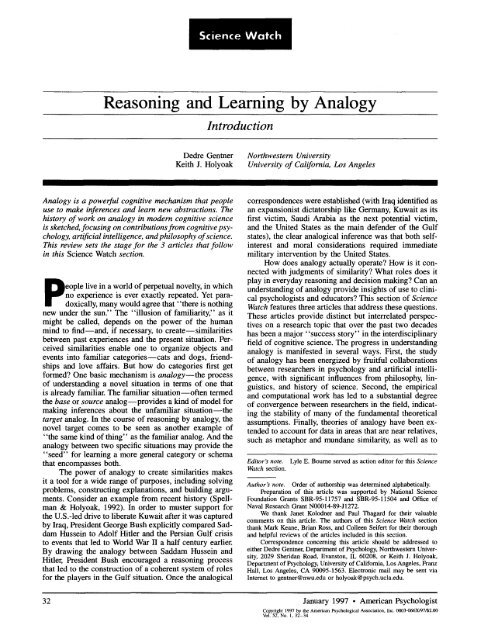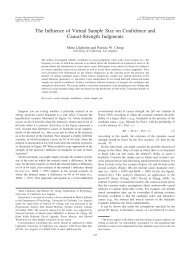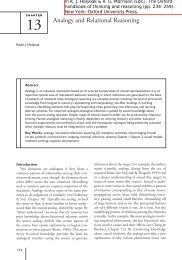Reasoning and Learning by Analogy - Abstract - American ...
Reasoning and Learning by Analogy - Abstract - American ...
Reasoning and Learning by Analogy - Abstract - American ...
You also want an ePaper? Increase the reach of your titles
YUMPU automatically turns print PDFs into web optimized ePapers that Google loves.
<strong>Reasoning</strong> <strong>and</strong> <strong>Learning</strong> <strong>by</strong> <strong>Analogy</strong><br />
Introduction<br />
Dedre Gentner<br />
Keith J. Holyoak<br />
Northwestern University<br />
University of California, Los Angeles<br />
<strong>Analogy</strong> is a powerful cognitive mechanism that people<br />
use to make inferences <strong>and</strong> learn new abstractions. The<br />
history of work on analogy in modern cognitive science<br />
is sketched, focusing on contributions from cognitive psychology,<br />
artificial intelligence, <strong>and</strong> philosophy of science.<br />
This review sets the stage for the 3 articles that follow<br />
in this Science Watch section.<br />
p<br />
eople live in a world of perpetual novelty, in which<br />
no experience is ever exactly repeated. Yet paradoxically,<br />
many would agree that there is nothing<br />
new under the sun." The "illusion of familiarity," as it<br />
might be called, depends on the power of the human<br />
mind to find--<strong>and</strong>, if necessary, to create--similarities<br />
between past experiences <strong>and</strong> the present situation. Perceived<br />
similarities enable one to organize objects <strong>and</strong><br />
events into familiar categories--cats <strong>and</strong> dogs, friendships<br />
<strong>and</strong> love affairs. But how do categories first get<br />
formed One basic mechanism is analogy--the process<br />
of underst<strong>and</strong>ing a novel situation in terms of one that<br />
is already familiar. The familiar situation--often termed<br />
the base or source analog--provides a kind of model for<br />
making inferences about the unfamiliar situation--the<br />
target analog. In the course of reasoning <strong>by</strong> analogy, the<br />
novel target comes to be seen as another example of<br />
"the same kind of thing" as the familiar analog. And the<br />
analogy between two specific situations may provide the<br />
"seed" for learning a more general category or schema<br />
that encompasses both.<br />
The power of analogy to create similarities makes<br />
it a tool for a wide range of purposes, including solving<br />
problems, constructing explanations, <strong>and</strong> building arguments.<br />
Consider an example from recent history (Spellman<br />
& Holyoak, 1992). In order to muster support for<br />
the U.S.-led drive to liberate Kuwait after it was captured<br />
<strong>by</strong> Iraq, President George Bush explicitly compared Saddam<br />
Hussein to Adolf Hitler <strong>and</strong> the Persian Gulf crisis<br />
to events that led to World War II a half century earlier.<br />
By drawing the analogy between Saddam Hussein <strong>and</strong><br />
Hitler, President Bush encouraged a reasoning process<br />
that led to the construction of a coherent system of roles<br />
for the players in the Gulf situation. Once the analogical<br />
correspondences were established (with Iraq identified as<br />
an expansionist dictatorship like Germany, Kuwait as its<br />
first victim, Saudi Arabia as the next potential victim,<br />
<strong>and</strong> the United States as the main defender of the Gulf<br />
states), the clear analogical inference was that both selfinterest<br />
<strong>and</strong> moral considerations required immediate<br />
military intervention <strong>by</strong> the United States.<br />
How does analogy actually operate How is it connected<br />
with judgments of similarity What roles does it<br />
play in everyday reasoning <strong>and</strong> decision making Can an<br />
underst<strong>and</strong>ing of analogy provide insights of use to clinical<br />
psychologists <strong>and</strong> educators This section of Science<br />
Watch features three articles that address these questions.<br />
These articles provide distinct but interrelated perspectives<br />
on a research topic that over the past two decades<br />
has been a major "success story" in the interdisciplinary<br />
field of cognitive science. The progress in underst<strong>and</strong>ing<br />
analogy is manifested in several ways. First, the study<br />
of analogy has been energized <strong>by</strong> fruitful collaborations<br />
between researchers in psychology <strong>and</strong> artificial intelligence,<br />
with significant influences from philosophy, linguistics,<br />
<strong>and</strong> history of science. Second, the empirical<br />
<strong>and</strong> computational work has led to a substantial degree<br />
of convergence between researchers in the field, indicating<br />
the stability of many of the fundamental theoretical<br />
assumptions. Finally, theories of analogy have been extended<br />
to account for data in areas that are near relatives,<br />
such as metaphor <strong>and</strong> mundane similarity, as well as to<br />
Editor's note. Lyle E. Bourne served as action editor for this Science<br />
Watch section.<br />
Author's note. Order of authorship was determined alphabetically.<br />
Preparation of this article was supported <strong>by</strong> National Science<br />
Foundation Grants SBR-95-11757 <strong>and</strong> SBR-95-11504 <strong>and</strong> Office of<br />
Naval Research Grant N00014-89-J1272.<br />
We thank Janet Kolodner <strong>and</strong> Paul Thagard for their valuable<br />
comments on this article. The authors of this Science Watch section<br />
thank Mark Keane, Brian Ross, <strong>and</strong> Colleen Seifert for their thorough<br />
<strong>and</strong> helpful reviews of the articles included in this section.<br />
Correspondence concerning this article should be addressed to<br />
either Dedre Gentner, Department of Psychology, Northwestern University,<br />
2029 Sheridan Road, Evanston, IL 60208, or Keith J. Holyoak,<br />
Department of Psychology, University of California, Los Angeles, Franz<br />
Hall, Los Angeles, CA 90095-1563. Electronic mail may be sent via<br />
Internet to gentner@nwu.edu or holyoak@psych.ucla.edu.<br />
32 January 1997 • <strong>American</strong> Psychologist<br />
Copyright 1997 <strong>by</strong> the <strong>American</strong> Psychological Association, Inc. 0003-066X/97/$2.00<br />
Vol. 52, No. 1, 32-34
areas that are more distant cousins, such as categorization<br />
<strong>and</strong> decision making.<br />
Modern views of analogy can be traced to such<br />
pioneering influences as the philosopher Mary Hesse<br />
(1966), whose treatise on analogy in science argued that<br />
analogies are powerful forces in discovery <strong>and</strong> conceptual<br />
change. For some time, howevel; most psychological<br />
work on analogy focused on four-term analogy problems<br />
of the sort used in intelligence tests (e.g., "foot is to leg<br />
as arm is to what") rather than on the richer analogies<br />
used in science <strong>and</strong> everyday life. In the early 1980s, two<br />
research projects in psychology began to take a broader<br />
view of analogy. Gentner (1982, 1983; Gentner & Gentner,<br />
1983) began working on mental models <strong>and</strong> analogy<br />
in science. She was struck <strong>by</strong> the idea that in analogy,<br />
the key similarities lie in the relations that hold within<br />
the domains (e.g., the flow of electrons in an electrical<br />
circuit is analogically similar to the flow of people in a<br />
crowded subway tunnel) rather than in features of individual<br />
objects (e.g., electrons do not resemble people).<br />
Moreover, analogical similarities often depend on higher<br />
order relations--relations between relations. For example,<br />
adding a resistor to a circuit causes (a higher order<br />
relation) a decrease in the flow of electricity, just as<br />
adding a narrow gate in a subway tunnel would decrease<br />
the rate at which people could pass through. In her structure-mapping<br />
theory, Gentner set forth the view that analogy<br />
entails finding a structural alignment, or a mapping,<br />
between domains. This alignment between two representational<br />
structures is characterized <strong>by</strong> structural parallelism<br />
(consistent, one-to-one correspondences between<br />
mapped elements) <strong>and</strong> systematicity--an implicit preference<br />
for deep, interconnected systems of relations governed<br />
<strong>by</strong> higher order relations, such as causal, mathematical,<br />
or functional relations.<br />
Holyoak (1985; Gick & Holyoak, 1980, 1983; Holyoak<br />
& Koh, 1987) became convinced that analogy offered<br />
a richer approach to problem solving than those that were<br />
then available. His focus on problem solving led him to<br />
a strong concern for the role of pragmatics in analogy--<br />
how current goals <strong>and</strong> context guide the interpretation<br />
of an analogy. Holyoak <strong>and</strong> Thagard (1989) developed a<br />
multiconstraint approach to analogy in which similarity,<br />
structural parallelism, <strong>and</strong> pragmatic factors interact to<br />
produce an interpretation. In addition, Holyoak's research<br />
on problem solving provided evidence that analogy<br />
can provide the seed for forming new relational categories,<br />
<strong>by</strong> abstracting the relational correspondences between<br />
examples into a schema for a class of problems.<br />
<strong>Analogy</strong> was viewed as a central part of human induction<br />
(Holl<strong>and</strong>, Holyoak, Nisbett, & Thagard, 1986).<br />
At the same time, researchers in artificial intelligence<br />
began to grapple with the use of complex analogies<br />
in reasoning <strong>and</strong> learning (Winston, 1980). Schank <strong>and</strong><br />
his colleagues were exploring the role of experience in<br />
underst<strong>and</strong>ing (Schank, 1982) <strong>and</strong> the relationship between<br />
underst<strong>and</strong>ing, learning, <strong>and</strong> memory (Kolodner,<br />
1983). This exploration soon led to a more general focus<br />
on the role of experience in reasoning <strong>and</strong> the relation-<br />
ships among reasoning, learning, <strong>and</strong> memory. Casebased<br />
reasoning (e.g., Kolodner, 1993; Kolodner &<br />
Simpson, 1989; Schank, Kass, & Riesbeck, 1994) was<br />
born from these explorations as a methodology for computer<br />
reasoning <strong>and</strong> as a plausible model of human reasomng.<br />
In contrast to rule-based approaches to reasoning<br />
(the dominant approach in artificial intelligence at the<br />
time), case-based reasoning emphasized the usefulness<br />
of retrieving <strong>and</strong> adapting cases or analogs stored in longterm<br />
memory when deriving solutions to novel problems.<br />
During recent years, the efforts of many cognitive<br />
scientists have contributed to an emerging consensus on<br />
many issues concerning analogy (e.g., Halford, 1993;<br />
Keane, Ledgeway, & Duff, 1994; Ross, 1989). The process<br />
of analogical thinking can be usefully decomposed<br />
into several basic constituent processes. One or more<br />
relevant analogs stored in memory must be accessed. A<br />
familiar analog must be mapped to the target analog to<br />
identify systematic correspondences between the two,<br />
there<strong>by</strong> aligning the corresponding parts of each analog.<br />
The resulting mapping allows analogical inferences to be<br />
made about the target analog, thus creating new knowledge<br />
to fill gaps in underst<strong>and</strong>ing. These inferences need<br />
to be evaluated <strong>and</strong> possibly adapted to fit the unique<br />
requirements of the target. Finally, in the aftermath of<br />
analogical reasoning, learning can result in the generation<br />
of new categories <strong>and</strong> schemas, the addition of new instances<br />
to memory, <strong>and</strong> new underst<strong>and</strong>ings of old instances<br />
<strong>and</strong> schemas that allow them to be better accessed<br />
in the future.<br />
All current theories of analogy deal with some subset<br />
of these basic component processes. In various ways<br />
<strong>and</strong> with differing emphases, all these theories make use<br />
of some combination of structural information about the<br />
form of the analogs <strong>and</strong> pragmatic information about the<br />
goals that triggered the reasoning episode. Theories of<br />
analogy have been instantiated in computer simulations.<br />
The output of a simulation can be compared to human<br />
performance with analogies, providing empirical grounding<br />
for the theoretical principles underlying the computer<br />
model.<br />
The three articles that follow illustrate some of the<br />
current research <strong>and</strong> theories of analogy use. Each article<br />
emphasizes particular issues <strong>and</strong> approaches. Holyoak<br />
<strong>and</strong> Thagard (1997) provide a number of examples of<br />
how analogies are used in contexts ranging from political<br />
debate to psychotherapy. They discuss these examples in<br />
terms of their multiconstraint theory, which posits a small<br />
number of basic principles that interact to guide analogical<br />
mapping <strong>and</strong> other aspects of analogy use. Gentner<br />
<strong>and</strong> Markman (1997) describe the structure-mapping theory,<br />
which emphasizes the structural principles on which<br />
mapping is based. They show how the structure-mapping<br />
theory provides insights into how similarities can be actively<br />
created as two analogs are aligned with one another.<br />
Kolodner (1997) provides an overview of the case-based<br />
reasoning approach as it applies to human <strong>and</strong> artificial<br />
intelligence <strong>and</strong> discusses some of its implications for<br />
design of educational practices <strong>and</strong> educational software.<br />
January 1997 • <strong>American</strong> Psychologist 33
Whereas the first two articles emphasize work on the<br />
mapping process, Kolodner's article focuses on how<br />
cases are retrieved <strong>and</strong> adapted. Each article sketches<br />
some of the computer simulations that have been developed<br />
to test theories of analogy <strong>and</strong> also raises some<br />
unanswered questions that invite further research.<br />
REFERENCES<br />
Gentner, D. (1982). Are scientific analogies metaphors In D. S. Miall<br />
(Ed.), Metaphor: Problems <strong>and</strong> perspectives (pp. 106-132). Brighton,<br />
Engl<strong>and</strong>: Harvester Press.<br />
Gentner, D. (1983). Structure-mapping: A theoretical framework. Cognitive<br />
Science, 7, 155-170.<br />
Gentner, D., & Gentner, D, R. (1983). Flowing waters or teeming<br />
crowds: Mental models of electricity. In D. Gentner & A. L. Stevens<br />
(Eds.), Mental models (pp. 99-129). HiUsdale, NJ: Erlbaum.<br />
Gentner, D., & Markman, A. B. (1997). Structure mapping in analogy<br />
<strong>and</strong> similarity. <strong>American</strong> Psychologist, 52, 45-56.<br />
Gick, M.L., & Holyoak, K.J. (1980). Analogical problem solving.<br />
Cognitive Psychology, 12, 306-355.<br />
Gick, M. L., & Holyoak, K. J. (1983). Schema induction <strong>and</strong> analogical<br />
transfer. Cognitive Psychology, 15, 1-38.<br />
Halford, G. S. (1993). Children's underst<strong>and</strong>ing: The development of<br />
mental models. Hillsdale, NJ: Erlbaum.<br />
Hesse, M. (1966). Models <strong>and</strong> analogies in science. Notre Dame, IN:<br />
Notre Dame University Press.<br />
Holl<strong>and</strong>, J. H,, Holyoak, K. J., Nisbett, R.E., & Thagard, P. (1986).<br />
Induction: Processes of inference, learning, <strong>and</strong> discovery. Cambridge,<br />
MA: MIT Press.<br />
Holyoak, K. J. (1985). The pragmatics of analogical transfer. In G. H.<br />
Bower (Ed.), The psychology of learning <strong>and</strong> motivation (Vol. 19,<br />
pp. 59-87). New York: Academic Press.<br />
Holyoak, K. J., & Koh, K. (1987). Surface <strong>and</strong> structural similarity in<br />
analogical transfer. Memory & Cognition, 15, 332-340.<br />
Holyoak, K. J., & Thagard, P. (1989). Analogical mapping <strong>by</strong> constraint<br />
satisfaction. Cognitive Science, 13, 295-355.<br />
Holyoak, K. J., & Thagard, P. (1997). The analogical mind. <strong>American</strong><br />
Psychologist, 52, 35-44.<br />
Keane, M. T., Ledgeway, T., & Duff, S. (1994). Constraints on analogical<br />
mapping: A comparison of three models. Cognitive Science, 18,<br />
387-438.<br />
Kolodner, J.L. (1983). Reconstructive memory: A computer model.<br />
Cognitive Science, 7, 281-328.<br />
Kolodner, J. L. (1993). Case-based reasoning. San Mateo, CA: Morgan<br />
Kaufmann,<br />
Kolodner, J. L. (1997). Educational implications of analogy: A view<br />
from case-based reasoning. <strong>American</strong> Psychologist, 52, 57-66.<br />
Kolodner, J. L., & Simpson, R. L. (1989). The MEDIATOR: Analysis<br />
of an early case-based problem solver. Cognitive Science, 13, 507-<br />
549.<br />
Ross, B. (1989). Distinguishing types of superficial similarities: Different<br />
effects on the access <strong>and</strong> use of earlier problems. Journal of<br />
Experimental Psychology: <strong>Learning</strong>, Memory, <strong>and</strong> Cognition, 15,<br />
456-468.<br />
Schank, R. C. (1982). Dynamic memory. New York: Cambridge University<br />
Press.<br />
Schank, R. C., Kass, A., & Riesbeck, C. K. (1994). Inside case-based<br />
explanation. Hillsdale, NJ: Erlbaum.<br />
Spellman, B.A., & Holyoak, K.J. (1992). If Saddam is Hitler then<br />
who is George Bush Analogical mapping between systems of social<br />
roles. Journal of Personality <strong>and</strong> Social Psychology, 62, 913-933.<br />
Winston, P. H. (1980). <strong>Learning</strong> <strong>and</strong> reasoning <strong>by</strong> analogy. Communications<br />
of the ACM, 23, 689-703.<br />
34 January 1997 • <strong>American</strong> Psychologist






